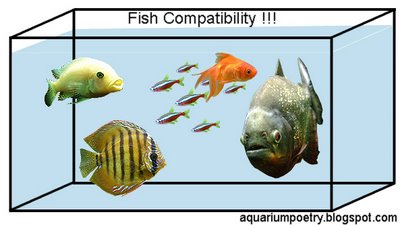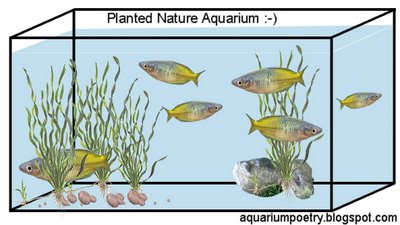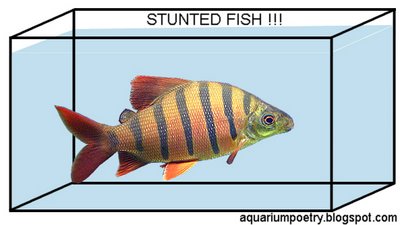What is responsible fish-keeping ?
 Every day, more and more people begin to realise that all animals deserve the same rights like we humans do. To live their lives without being terrorised, imprisoned or starved. Every living creature deserves a good life, so does the one behind the aquarium glass!
Every day, more and more people begin to realise that all animals deserve the same rights like we humans do. To live their lives without being terrorised, imprisoned or starved. Every living creature deserves a good life, so does the one behind the aquarium glass!The way you care for your fish/invertebrate, will determine in which category you will fall in. There are two categories; Fish-Keepers and Fish-Havers !
Fish-Keeping is considered responsible and very pleasing to our fish-pet, while Fish-Having is considered very irresponsible and bad for our fish-pet!
A Fish-Keeper will put fish requirements first and the personal pleasure second.
A Fish-Haver will ... well, have floating/crammed fish bodies in a little amount of polluted water!
How can I become a Fish-Keeper :-) ???
1. Do not stunt your fish!
Before buying an aquarium, the best thing to do, is to do a wide research. Knowing what fish you would like to keep, means knowing what size of an aquarium you will need to purchase. Small shoaling species (up to 5cm) can be housed in between 10 and 20 gallons (depending on how many fish is in the shoal of course), while species like most Gouramies, Rainbowfish or Angelfish (10-15cm) will need at least 48 gallons to thrive, depending on how many fish is kept of course. Housing a big fish in a small tank is a wrong thing to do! Even as a juvenile, fish that grows to a bigger size (15cm and up) will stop growing in small tanks, causing this fish do die premature.
Many people believe that a fish will grow to the size of an aquarium. Meaning, if a (30cm) Clown Loach (Botia macracanthus) grows in a 40 liters aquarium, it will stay approximately 8cm. THIS IS A WRONG THING TO DO! Yes! The fish will stay smaller, but as well as that, that fish will die premature because of being stressed all the time. Fish can sense small space around them. Please try to do a wide research before purchasing any fish or invertebrate :-)
2. Do not over-stock your aquarium!
 Over-stocking your tank with fish/invertebrates, is a sure way towards Disease and Disaster! Believe me, there is no joy in watching crammed bodies inside an aquarium. All creatures prefer to have their own space and comfort! Yes, the fish too! How would you feel being locked up, for the rest of your life, inside of your living room, together with 20 other persons...and that is not the end...the same room is to be used as a toilet too! Yes, I know...disgusting! Trust me, if fish could talk, they probably would scream in most cases. That is why it is very important to spread the philosophy of responsible fish-keeping and help other fish by educating their owners :-)
Over-stocking your tank with fish/invertebrates, is a sure way towards Disease and Disaster! Believe me, there is no joy in watching crammed bodies inside an aquarium. All creatures prefer to have their own space and comfort! Yes, the fish too! How would you feel being locked up, for the rest of your life, inside of your living room, together with 20 other persons...and that is not the end...the same room is to be used as a toilet too! Yes, I know...disgusting! Trust me, if fish could talk, they probably would scream in most cases. That is why it is very important to spread the philosophy of responsible fish-keeping and help other fish by educating their owners :-)
How will I know did I reach my stocking limit? (for fresh-water only)
Good question! First of all, no fish should be kept in tanks smaller than 10 gallons (38 liters), no matter how small the fish is. Small tanks are very difficult to manage, since they get polluted very fast and the ammonia/nitrite can build up very fast and seriously damage the fish.
10 gallon long and 10 gallon tall tank can't hold the same bio-load. The water surface plays a big role, because the oxygen exchange is larger in aquariums with wider surfaces. Even though both tanks, the long and the tall one, have the same amount of 10 gallons (for example), only the long one can support more fish. Always go for long aquariums, your fish will appreciate it.
The rule of thumb is something that will help a lot in determine how many fish you can keep in your aquarium. For example;
A 53 gallon long (200 liters) aquarium can hold up to 140 cm of fish (adult size).
A 26.5 gallon long (100 liters) aquarium can support up to 70 cm of fish (adult size).
NOTE; the rule of thumb applies for small species only that grow to maximum of 7 cm. Bigger species waste more, meaning, will pollute the water much faster. For example;
A 53 gallon long (200 liters) aquarium can hold only 2 Discus fish (adult size 15cm), and in a case of a planted aquarium, one small shoal of Tetras (adult size 5cm) can be introduced with them.
This doesn't mean that you can keep one Discus in a 26.5 gallons long (100 liters) aquarium. That aquarium could hardly support this deep-bodied fish. As we mentioned above, do not stunt your fish!!!
3. Do not use the Fish-Cycling method !!!
 Every new set-up needs to be cycled in accordance to build up the nitrifying bacteria that will break down the fish waste from ammonia (NH3) into nitrite (NO2-) and then into nitrate (NO3-). To establish a healthy growing bacteria colony, one have to provide ammonia source for the bacteria to feed on. In the first few weeks the ammonia and nitrite spike very high to the levels that are seriously dangerous for the fish! Fish is used in this method to provide waste for the bacteria to grow. Why would anyone sane expose a little fish to dangerous ammonia/nitrite just for that reason?! It is enough to put a raw prawn instead of the fish, and for sure the rotting prawn will provide lots more of ammonia than the poor stressed fish. How does a fish feel when exposed to ammonia/nitrite? Good question! How would you feel if your eyes would be exposed to a hair shampoo and you are not able to rinse it out nor to scream for help? I know... horrible! Fish exposed to Fish-cycling will be permanently damaged and will die premature. There are better ways to start your new aquarium: Fishless Cycling and Silent Cycling methods are recommended.
Every new set-up needs to be cycled in accordance to build up the nitrifying bacteria that will break down the fish waste from ammonia (NH3) into nitrite (NO2-) and then into nitrate (NO3-). To establish a healthy growing bacteria colony, one have to provide ammonia source for the bacteria to feed on. In the first few weeks the ammonia and nitrite spike very high to the levels that are seriously dangerous for the fish! Fish is used in this method to provide waste for the bacteria to grow. Why would anyone sane expose a little fish to dangerous ammonia/nitrite just for that reason?! It is enough to put a raw prawn instead of the fish, and for sure the rotting prawn will provide lots more of ammonia than the poor stressed fish. How does a fish feel when exposed to ammonia/nitrite? Good question! How would you feel if your eyes would be exposed to a hair shampoo and you are not able to rinse it out nor to scream for help? I know... horrible! Fish exposed to Fish-cycling will be permanently damaged and will die premature. There are better ways to start your new aquarium: Fishless Cycling and Silent Cycling methods are recommended.
4. Think about fish compatibility and their requirements!
 Not all fishes are compatible with each other. You should be aware not to mix aggressive species with calm, placid, species. Fast moving fish will very likely stress out the slow moving ones. Cold water fish should not be mixed with tropical fish. They require different water temperatures.
Not all fishes are compatible with each other. You should be aware not to mix aggressive species with calm, placid, species. Fast moving fish will very likely stress out the slow moving ones. Cold water fish should not be mixed with tropical fish. They require different water temperatures.
African Lake Cichlids require hard alkaline water and should not be mixed with Amazon Basin Cichlids that require soft and acidic water conditions. Shoaling fish prefer to be kept in groups of their own kind otherwise if on its own, will tend to hide all the time and eventually will die. Shoaling fish enjoys safety in numbers. Some species prefer lots of live plants while others benefit from lots of heavy rock-work.
The best thing to do is to ask questions on different aqua forums and compare peoples opinions and experiences. That is the best way towards becoming a responsible fish-keeper!
5. Establish a healthy Planted Nature aquarium :-)
 Live plants and algae play an essential role in the ECO-system. All fish will benefit from live plants and algae. For example; Many species will supplement their diet with soft leaved plants like Hygrophila polysperma. Algae eaters like Otocinclus will have round healthy bellies if there is plenty of Brown algae in the tank. Siamese Algae Eater will graze over Green Beard algae, Hair algae and Black Brush algae. Shrimps will eat microorganisms and decaying plant material, snails will do the same. And there you see your aquarium becoming a busy little Eco-system. This is not the end. Plants will do more than just supplement food for the fishes. They will uptake all the ammonia/nitrIte/nitrAte produced by the fish waste and decaying material, making your aquarium a healthy place. Plants will uptake CO2 produced by fish, and together with lights, will photosynthesize and produce Oxygen (O2) . Oxygen is used up by fish through gills. In times of stress, plants provide shelter for fish to refuge into. Planting lots of plants will reduce aggressiveness in general, and the fish will be less exposed to bullying and stress.
Live plants and algae play an essential role in the ECO-system. All fish will benefit from live plants and algae. For example; Many species will supplement their diet with soft leaved plants like Hygrophila polysperma. Algae eaters like Otocinclus will have round healthy bellies if there is plenty of Brown algae in the tank. Siamese Algae Eater will graze over Green Beard algae, Hair algae and Black Brush algae. Shrimps will eat microorganisms and decaying plant material, snails will do the same. And there you see your aquarium becoming a busy little Eco-system. This is not the end. Plants will do more than just supplement food for the fishes. They will uptake all the ammonia/nitrIte/nitrAte produced by the fish waste and decaying material, making your aquarium a healthy place. Plants will uptake CO2 produced by fish, and together with lights, will photosynthesize and produce Oxygen (O2) . Oxygen is used up by fish through gills. In times of stress, plants provide shelter for fish to refuge into. Planting lots of plants will reduce aggressiveness in general, and the fish will be less exposed to bullying and stress.
 These days, all municipal waters are treated with chloramine to prevent bacteria from developing in the water pipes. Chloramine is very poisonous for fish and invertebrates and will permanently damage their health and cause premature death. Chloramine will instantly kill the beneficial nitrifying bacteria inside the filter media and gravel. To prevent all this we have to use water conditioners (dechlorinators) to remove chloramine from the water. Never release new live-stock into an aquarium that hasn't been treated with dechlorinator !!!
These days, all municipal waters are treated with chloramine to prevent bacteria from developing in the water pipes. Chloramine is very poisonous for fish and invertebrates and will permanently damage their health and cause premature death. Chloramine will instantly kill the beneficial nitrifying bacteria inside the filter media and gravel. To prevent all this we have to use water conditioners (dechlorinators) to remove chloramine from the water. Never release new live-stock into an aquarium that hasn't been treated with dechlorinator !!!
7. Fish needs a balanced diet to thrive !
Fish diet is something many aquarists take for granted and feed just once a day or too many times a day, and in most cases the fish are fed with flake food only. It is not that easy establishing balanced diet for our fish-pet, but it is not impossible either. Research about your fish. Some fish are insectivorous, some carnivorous, other herbivorous, and most would fall into the omnivorous category. Observe your fish. Feed small amounts and check on it. The amount your fish can eat in two minutes should be enough for the first feeding. Some aquarists feed 3-4 times a day, I do 2 times. It is good to feed your fish with different food. For example; first time can be fed with freeze dried food and the second with staple flake food. Blanched lettuce is a good supplement for green food. Never leave the left over food to sit in the aquarium for long. Take it out. If your fish takes the offered food in to the mouth and spits it out, that should be a sign for you to change the food. Not all fish eat everything thats offered. Overfeeding is much worse than underfeeding since it will pollute the water and will lead to obesity. Do not forget the bottom-dwellers! They are slow eaters and little is left behind for them to eat. The best thing is to feed sinking tablet food after the tank lights are off, since many bottom-dwellers are nocturnal. Algae wafers are something to be fed to algae eating fish like plecos as well as blanched zucchini. Unbalanced diet can lead to a disaster. When fish are under stress their metabolism is weak and disease wil more likely strike. But if the fish have been fed a good balanced diet, they are able to resist the disease. One day a week your fish should be fasting (no food offered) since it will clean their digestion system and the fish will become more active in search for food. An overfed fish is a very sick fish as well as the underfed one. Balance the diet. The fish belly shows wheteher your fish is being fed properly or not. Neither a bloated stomach nor a fallen in stomach are good signs, but a nice round stomach is a sure way to know that you are providing your fish with the right diet.
I made a video that will show you the way commercial food like crumbs, flake or chips should be prepared as well as some freez dried worms. Always presoak the food in a bit of the aquarium water, for a minute, so it doesn't stay for too long at the surface. I do that because some fish like my Angels will go up and stuff themselves while the rest of the inhabitants will stay hungry. To avoid this one should always presoak the food that will immediately slowly sink down giving everybody the same opportunity to feed. Sprinkle the food all over the tank to separate the aggressive feeders from the placid ones. Some food should find it's way to the bottom for fish like Corys and various shrimps. I feed half a tea spoon (each meal) for two 12 cm Angels, two 10 cm SAE, 11 grown Cardinal tetras, 5 Amano shrimps and 2 grown Otos. The second meal are freez dried Tubifex worms (half the cube) also presoaked. Link to the VIDEO here.
 There you go, it is not really difficult, is it :-) Fish-Keeping is all about caring for the creature behind the aquarium glass that was placed there by us, humans, without its will. It is our responsibility to give this creature all it needs to live a full and happy life. So lets do it together! Join Responsible Fish-Keeping and make Fish-Having history !!!
There you go, it is not really difficult, is it :-) Fish-Keeping is all about caring for the creature behind the aquarium glass that was placed there by us, humans, without its will. It is our responsibility to give this creature all it needs to live a full and happy life. So lets do it together! Join Responsible Fish-Keeping and make Fish-Having history !!!
Article written and illustrated by Dusko Bojic


